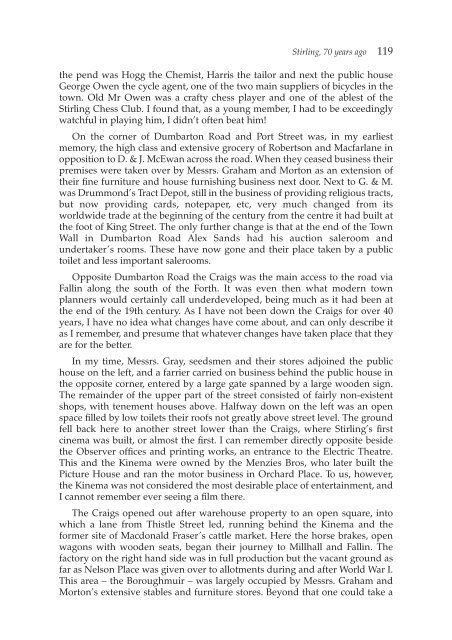the Forth Naturalist Historian - Forth Naturalist and Historian ...
the Forth Naturalist Historian - Forth Naturalist and Historian ...
the Forth Naturalist Historian - Forth Naturalist and Historian ...
You also want an ePaper? Increase the reach of your titles
YUMPU automatically turns print PDFs into web optimized ePapers that Google loves.
Stirling, 70 years ago 119<br />
<strong>the</strong> pend was Hogg <strong>the</strong> Chemist, Harris <strong>the</strong> tailor <strong>and</strong> next <strong>the</strong> public house<br />
George Owen <strong>the</strong> cycle agent, one of <strong>the</strong> two main suppliers of bicycles in <strong>the</strong><br />
town. Old Mr Owen was a crafty chess player <strong>and</strong> one of <strong>the</strong> ablest of <strong>the</strong><br />
Stirling Chess Club. I found that, as a young member, I had to be exceedingly<br />
watchful in playing him, I didn’t often beat him!<br />
On <strong>the</strong> corner of Dumbarton Road <strong>and</strong> Port Street was, in my earliest<br />
memory, <strong>the</strong> high class <strong>and</strong> extensive grocery of Robertson <strong>and</strong> Macfarlane in<br />
opposition to D. & J. McEwan across <strong>the</strong> road. When <strong>the</strong>y ceased business <strong>the</strong>ir<br />
premises were taken over by Messrs. Graham <strong>and</strong> Morton as an extension of<br />
<strong>the</strong>ir fine furniture <strong>and</strong> house furnishing business next door. Next to G. & M.<br />
was Drummond’s Tract Depot, still in <strong>the</strong> business of providing religious tracts,<br />
but now providing cards, notepaper, etc, very much changed from its<br />
worldwide trade at <strong>the</strong> beginning of <strong>the</strong> century from <strong>the</strong> centre it had built at<br />
<strong>the</strong> foot of King Street. The only fur<strong>the</strong>r change is that at <strong>the</strong> end of <strong>the</strong> Town<br />
Wall in Dumbarton Road Alex S<strong>and</strong>s had his auction saleroom <strong>and</strong><br />
undertaker’s rooms. These have now gone <strong>and</strong> <strong>the</strong>ir place taken by a public<br />
toilet <strong>and</strong> less important salerooms.<br />
Opposite Dumbarton Road <strong>the</strong> Craigs was <strong>the</strong> main access to <strong>the</strong> road via<br />
Fallin along <strong>the</strong> south of <strong>the</strong> <strong>Forth</strong>. It was even <strong>the</strong>n what modern town<br />
planners would certainly call underdeveloped, being much as it had been at<br />
<strong>the</strong> end of <strong>the</strong> 19th century. As I have not been down <strong>the</strong> Craigs for over 40<br />
years, I have no idea what changes have come about, <strong>and</strong> can only describe it<br />
as I remember, <strong>and</strong> presume that whatever changes have taken place that <strong>the</strong>y<br />
are for <strong>the</strong> better.<br />
In my time, Messrs. Gray, seedsmen <strong>and</strong> <strong>the</strong>ir stores adjoined <strong>the</strong> public<br />
house on <strong>the</strong> left, <strong>and</strong> a farrier carried on business behind <strong>the</strong> public house in<br />
<strong>the</strong> opposite corner, entered by a large gate spanned by a large wooden sign.<br />
The remainder of <strong>the</strong> upper part of <strong>the</strong> street consisted of fairly non-existent<br />
shops, with tenement houses above. Halfway down on <strong>the</strong> left was an open<br />
space filled by low toilets <strong>the</strong>ir roofs not greatly above street level. The ground<br />
fell back here to ano<strong>the</strong>r street lower than <strong>the</strong> Craigs, where Stirling’s first<br />
cinema was built, or almost <strong>the</strong> first. I can remember directly opposite beside<br />
<strong>the</strong> Observer offices <strong>and</strong> printing works, an entrance to <strong>the</strong> Electric Theatre.<br />
This <strong>and</strong> <strong>the</strong> Kinema were owned by <strong>the</strong> Menzies Bros, who later built <strong>the</strong><br />
Picture House <strong>and</strong> ran <strong>the</strong> motor business in Orchard Place. To us, however,<br />
<strong>the</strong> Kinema was not considered <strong>the</strong> most desirable place of entertainment, <strong>and</strong><br />
I cannot remember ever seeing a film <strong>the</strong>re.<br />
The Craigs opened out after warehouse property to an open square, into<br />
which a lane from Thistle Street led, running behind <strong>the</strong> Kinema <strong>and</strong> <strong>the</strong><br />
former site of Macdonald Fraser’s cattle market. Here <strong>the</strong> horse brakes, open<br />
wagons with wooden seats, began <strong>the</strong>ir journey to Millhall <strong>and</strong> Fallin. The<br />
factory on <strong>the</strong> right h<strong>and</strong> side was in full production but <strong>the</strong> vacant ground as<br />
far as Nelson Place was given over to allotments during <strong>and</strong> after World War I.<br />
This area – <strong>the</strong> Boroughmuir – was largely occupied by Messrs. Graham <strong>and</strong><br />
Morton’s extensive stables <strong>and</strong> furniture stores. Beyond that one could take a



